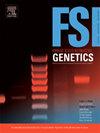线粒体基因组测序与ForenSeq™mtDNA全基因组试剂盒。
IF 3.1
2区 医学
Q2 GENETICS & HEREDITY
引用次数: 0
摘要
线粒体DNA (mtDNA)具有独特的遗传特征,在法医DNA分析中起着至关重要的作用。基于大规模平行测序(MPS)技术和短重叠扩增子方法,ForenSeq™mtDNA全基因组试剂盒专为mtDNA分析而设计。在本研究中,我们在MiSeq FGx®测序系统上使用ForenSeq™mtDNA全基因组试剂盒进行线粒体基因组(mtGenome)连续9次测序,并评估其MPS性能,如读取深度(RD)、正向/反向链偏置(SB)和mtGenome覆盖率。此外,我们还进行了内部验证,以评估其在法医科学中的常规应用,包括灵敏度、可重复性、一致性、降解样品、抑制剂样品、病例类型样品和污染。结果,实时分析(等)和通用分析软件(UAS)展示熟练运行时的性能指标和国会议员12 - 14库测序在标准流细胞,实现> 80 %的读取通过过滤器,> 80年 %基地与≥Q30, > 5000年 × 平均,平均的1.0∼某人,> 70年 % inter-amplicon平衡,,> 99年 % mtGenome报道。5个最易受攻击的扩增子分别位于1094-1177、5858-5975、6109-6149、6718-6810和7021-7090核苷酸位置,表现为低RD和高SB。对于三级数据分析,替换可以由UAS准确报告,而插入和缺失(indels)、点异质(PHPs)和/或长度异质(lhp)仍然需要人工检查。平均而言,在60个样本中发现了40个变异,从27到54不等。在491个nps中共观察到2426个变异。此外,该工作流程可以产生可重复和可重现的结果,从≥ 2 pg的高质量样品/对照DNA或≥ 0.5 cm毛轴的输入gDNA中生成完整的mtGenome图谱,并从严重降解的样品(降解指数bbb10)和各种类型的病例样品中恢复更多/完整的mtGenome信息。如果进行两轮纯化,它可以更有效地去除额外的反应成分,并提高mtGenome的数据回收率,特别是对于低输入样本。三次运行的阴性对照覆盖了一些读数,但这些污染不能损害线粒体分析。综上所述,包含234个平均长度为131 bp的短重叠扩增子的ForenSeq™mtDNA全基因组试剂盒,可以满足实际场景中法医对mtGenome全基因组测序的需求。此外,从本研究中获得的十个见解可以作为使用该工具包的法医科学家的宝贵参考。本文章由计算机程序翻译,如有差异,请以英文原文为准。
Mitochondrial genome sequencing with ForenSeq™ mtDNA Whole Genome Kit
Mitochondrial DNA (mtDNA) possesses unique genetic characteristics and plays a crucial role in forensic DNA analysis. Based on the massively parallel sequencing (MPS) technology alongside the short overlapping amplicon method, the ForenSeq™ mtDNA Whole Genome Kit is specifically designed for mtDNA analysis. In this study, we employ the ForenSeq™ mtDNA Whole Genome Kit on the MiSeq FGx® Sequencing System for mitochondrial genome (mtGenome) sequencing across nine consecutive runs and assess its MPS performance, such as read depth (RD), forward/reverse strand bias (SB), and mtGenome coverage. Furthermore, we conduct internal validations to evaluate its routine application in forensic sciences, including sensitivity, repeatability, concordance, degraded samples, inhibitor samples, case-type samples, and contamination. As a result, the Real-Time Analysis (RTA) and Universal Analysis Software (UAS) demonstrate proficient run metrics and MPS performance when 12–14 libraries are sequenced within a standard flow cell, achieving > 80 % of reads passing filter, > 80 % bases with ≥Q30, > 5000 × of the average RD, ∼1.0 of the average SB, > 70 % of the inter-amplicon balance, and > 99 % of the mtGenome coverage. The five most vulnerable amplicons, exhibiting low RD and high SB, are identified as nucleotide positions (nps) 1094–1177, 5858–5975, 6109–6149, 6718–6810, and 7021–7090. For tertiary data analysis, the substitutions are accurately reported by UAS, while insertions and deletions (indels), point heteroplasmies (PHPs), and/or length heteroplasmies (LHPs) still necessitate manual inspection. On average, 40 variants were found in 60 samples, ranging from 27 to 54. A total of 2426 variants are observed at 491 nps. Moreover, the workflow can yield repeatable and reproducible results, generate complete mtGenome profiles from ≥ 2 pg input gDNA for high quality samples/control DNA or ≥ 0.5 cm hair shafts, and recover more/complete mtGenome information from severely degraded samples (degradation index >10) and various types of case samples. If two rounds of purification are conducted, it can more effectively remove additional reaction components and enhance data recovery from the mtGenome, especially for low-input samples. The negative controls in three runs cover some reads, but these contaminations cannot compromise the mitochondrial analyses. In conclusion, the ForenSeq™ mtDNA Whole Genome Kit, including 234 short overlapping amplicons with an average size of 131 bp, can meet forensic needs on the whole mtGenome sequencing in real scenarios. In addition, the ten insights gained from this study may serve as a valuable reference for forensic scientists who are utilizing this kit.
求助全文
通过发布文献求助,成功后即可免费获取论文全文。
去求助
来源期刊
CiteScore
7.50
自引率
32.30%
发文量
132
审稿时长
11.3 weeks
期刊介绍:
Forensic Science International: Genetics is the premier journal in the field of Forensic Genetics. This branch of Forensic Science can be defined as the application of genetics to human and non-human material (in the sense of a science with the purpose of studying inherited characteristics for the analysis of inter- and intra-specific variations in populations) for the resolution of legal conflicts.
The scope of the journal includes:
Forensic applications of human polymorphism.
Testing of paternity and other family relationships, immigration cases, typing of biological stains and tissues from criminal casework, identification of human remains by DNA testing methodologies.
Description of human polymorphisms of forensic interest, with special interest in DNA polymorphisms.
Autosomal DNA polymorphisms, mini- and microsatellites (or short tandem repeats, STRs), single nucleotide polymorphisms (SNPs), X and Y chromosome polymorphisms, mtDNA polymorphisms, and any other type of DNA variation with potential forensic applications.
Non-human DNA polymorphisms for crime scene investigation.
Population genetics of human polymorphisms of forensic interest.
Population data, especially from DNA polymorphisms of interest for the solution of forensic problems.
DNA typing methodologies and strategies.
Biostatistical methods in forensic genetics.
Evaluation of DNA evidence in forensic problems (such as paternity or immigration cases, criminal casework, identification), classical and new statistical approaches.
Standards in forensic genetics.
Recommendations of regulatory bodies concerning methods, markers, interpretation or strategies or proposals for procedural or technical standards.
Quality control.
Quality control and quality assurance strategies, proficiency testing for DNA typing methodologies.
Criminal DNA databases.
Technical, legal and statistical issues.
General ethical and legal issues related to forensic genetics.

 求助内容:
求助内容: 应助结果提醒方式:
应助结果提醒方式:


